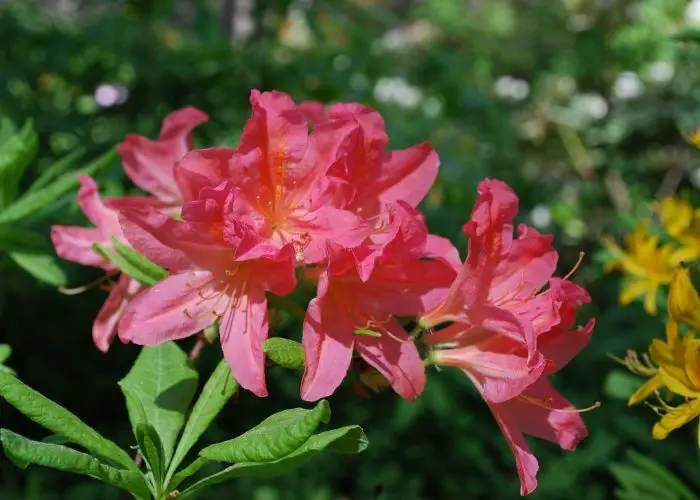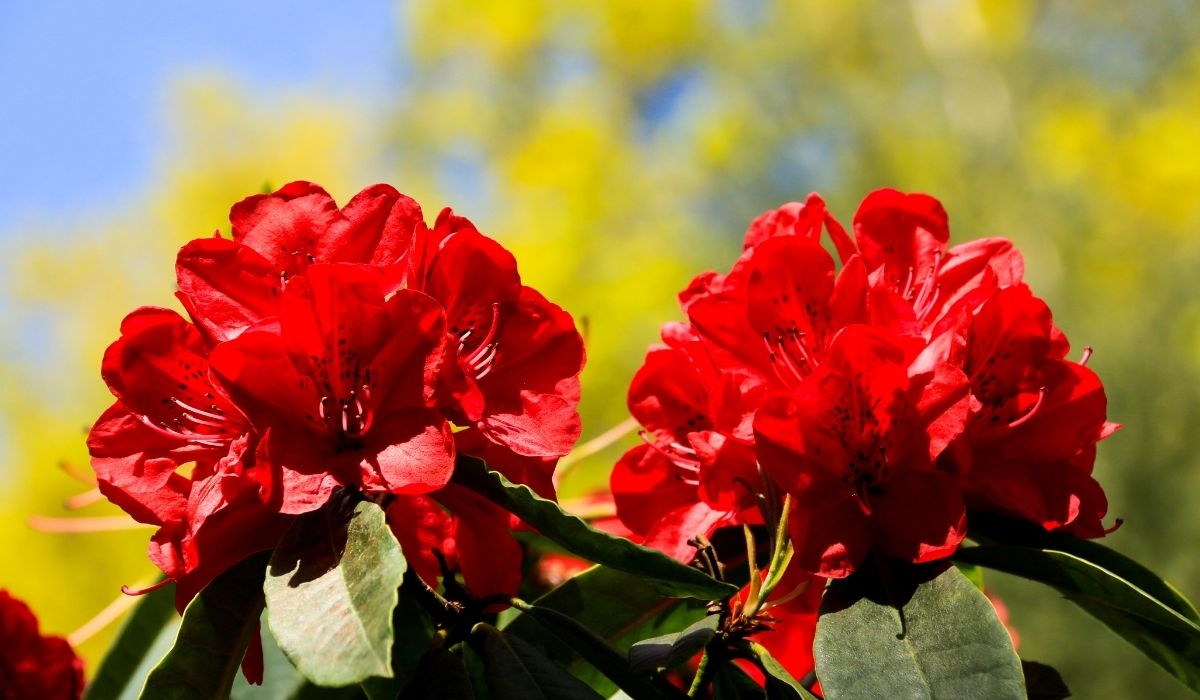Last Updated on August 11, 2022 by Cinthia
When to plant rhododendrons is one of the things to consider when growing these flowers to get them ready for bloom at the right time.
Rhododendrons are famous and much-loved landscaping flowering shrubs; native to Asia and grown across the world. Their large blossoms in hues of pink, red, purple, and white bloom each spring, attracting all the pollinating insects.
This ornamental shrub is a member of the azalea family and requires very minimal care and maintenance once it’s established. It’s prone to insect infestation and requires little pruning.
There are thousands of colorful rhododendron cultivars to choose from that range in sizes to suit your containers or gardens. Mini rhododendrons are evergreen, but the decedent’s variety provides a beautiful autumn color.
When To Plant Rhododendrons
The best time to plant rhododendron is early spring when the danger of frost has passed. However, the American rhododendron society recommends the following planting season based on your climate.
- Mild climate – plant a rhododendron all year round
- Cold temperatures – plant early spring or early fall as a second choice
- Hot climates – plant your rhododendrons in the fall to allow their root system to establish during the cold months
Planting rhododendron is done in already prepared soil that drains well. You are likely to purchase your rhododendron plant in a container or burlapped specimen. Before planting, soak the root ball in water until the air bubbles disappear. After that, plant it in your garden or container.
Propagating Rhododendron
Planting rhododendron cuttings is the easiest and fastest technique to propagate this plant.
Preparing rhododendron cuttings can happen all summer long. Here are some steps that you can follow
- Collect your rhododendrons cuttings from non-flowering stems at least 6 to 8 inches long
- Remove the lower pairs of leaves, leaving only the topmost
- Deep the base of your cuttings in powdered rooting agents to help them get roots faster
- Place your cuttings in nursery pots filled with potting soil mix
- Keep your soil mix moist and ensure the plants are near light but not under direct sunlight.
How To Grow Rhododendrons
Rhododendrons are ideally grown at the border or a shady spot. They love humus-rich acidic soil in a sport where they receive both shade and sun partially. Plant them in an area where they don’t get exposed to constant winds, mainly the salty winds of the marine environment.
Rhododendrons are acid-loving plants thriving in acidic soil with a PH value of 4.5 to 6.0. They require well-draining soil with an abundance of organic matter. You can use compost or decomposed pine bark organic fertilizer to amend your soil.
Caring For Rhododendrons
- Watering. Rhododendrons have shallow find roots that require regular watering in dry periods. They show signs of drought or dryness much sooner than plants that have deeper roots. And show that you keep the soil moist but not waterlogged.
- Mulching. Mulching with compost back chips or pine needles preserves the soil moisture and prevents weeds. Replenishing your mulch annually is essential for your plants.
- Pruning. It is essential to prune rhododendrons’ shrubs to show off their trunks or give a particular shape. Prune them right after blooming, but be careful not to cut off the following year’s buds. Give them a light trim after the bloom phase to encourage new growth another bloom in summer.
- Fertilizing. Preparing yourself before planting requires you to fertilize the soil either with organic material or fertilizer as necessary. If you think your soil requires additional nutrients apply the right fertilizer designed for acid-loving plants in late winter or early spring.
- Managing pests and diseases. Rhododendrons are susceptible to the following conditions – petal blight, gall, powdery mildew, branch dieback, and root rot. These pests can also be a problem to rhododendrons; they include thrips, weevils, aphids, lace bugs, rhododendron borer, Azalea caterpillar, spider mites, and leaf miners. The best way to prevent diseases and pests damage to your rhododendron plants is to ensure they are properly planted and given the proper maintenance.
Recommended Varieties Of Rhododendrons To Plant
Over 900 species in the Rhododendron genus, so how do you choose the right one to grow in your region? The American Rhododendron Society runs a database with over 2,000 rhododendrons and azaleas varieties you can choose from. Here are some types that you might love,
- Purple Gem. This is a dwarf rhododendron that grows to 2 feet tall. It is an early bloomer bearing small, light purple flowers. It is best for a rock garden or the front of a border in USDA Zones 5 to 8.
- Blue Diamond. This is a dwarf evergreen rhododendron growing to at least 5 feet tall. It thrives in USDA zones 7 to 9, blooming midseason with violet-blue flowers.
- Rosy Lights. This variety does well in extra cold hardiness zones 3 to 8. It grows up to 4 feet tall and bears deep purple-pink flowers.
- Nova Zembla.This evergreen rhododendron grows to at least 5 to 10 feet tall, bearing bright red flowers in late midseason. It thrives in USDA hardiness zones 5 to 8.
- Cecile. It’s a vigorous plant that thrives in USDA hardiness zones 5 to 8. It grows to 7 feet tall, producing dark salmon-pink buds in midseason.
- Hydon Dawn. This is a low-growing rhododendron that tolerates full sun in USDA hardiness zones 7 to 9. It blooms in midseason with pale pink flowers.

Conclusion
Now that you know when to plant rhododendrons, it is advisable to visit the following gardens and learn more about these flowers.
- The Rhododendron Species Foundation Botanical Garden. This is the world’s most extensive collection covering 22 acres in conifer forest south of Seattle. It has over 600 of the 1000+ identified species.
- Crystal Springs Rhododendron Garden. This 7-acre garden is located in downtown Portland and can be visited in April and May when the plants bloom. It contains an outstanding collection of rare species and hybrids.
- The Rhododendron State Park. This park is in Fitzwilliam, New Hampshire, featuring a 16-acre land of rhododendron maximum. This species has soft pink, almost white flower and is the only species native to New England. Visit this park in July, when the fragrant clusters of pink blossoms are blooming.
- Heritage Museums and Gardens. This venue hosts an annual Rhododendrons Festival in Cape Cod, an exciting place to see many varieties in bloom. You can participate in various gardening activities with horticultural experts surrounded by the fantastic scenery of flowers.
Caroline is a gardener who loves to get down to the nitty–gritty of gardening. She proudly proclaims herself as a ‘dirt worshipper‘ and can often be found deep in the garden, covered in soil and singing to her plants. As a self–proclaimed ‘plant whisperer‘, Caroline believes that plants need love and attention just like any other living thing, and she loves to give them both. When she‘s not tending to her garden, you can often find her researching the latest gardening trends, or teaching others how to make their gardens thrive



